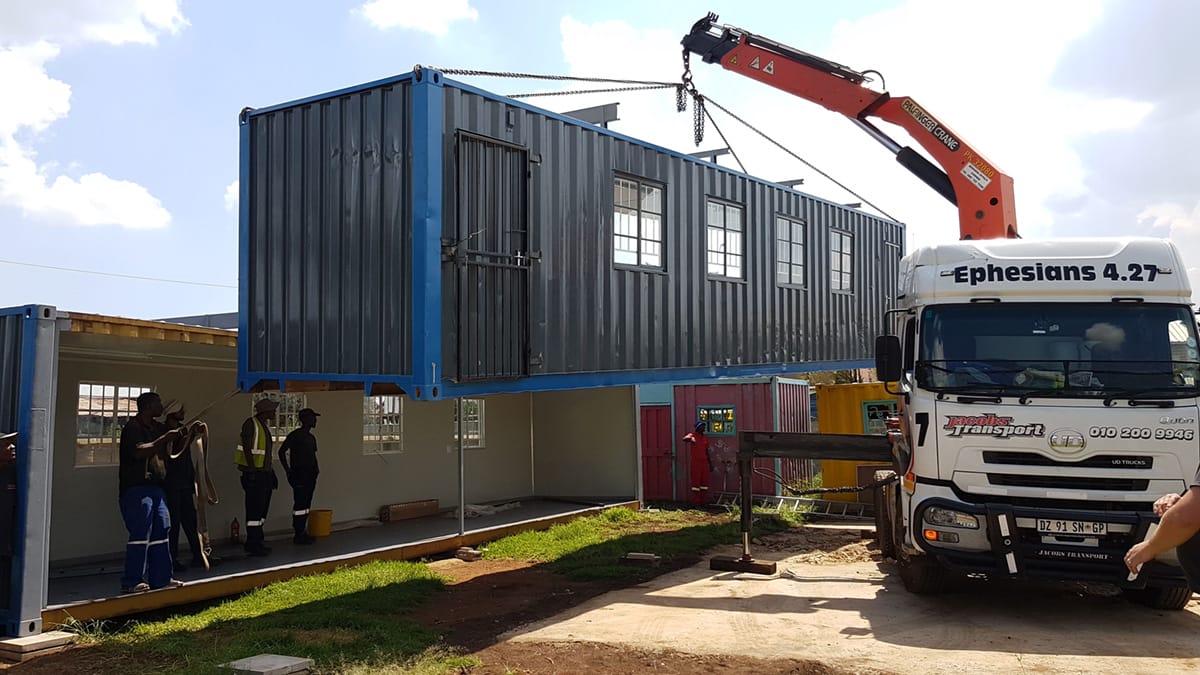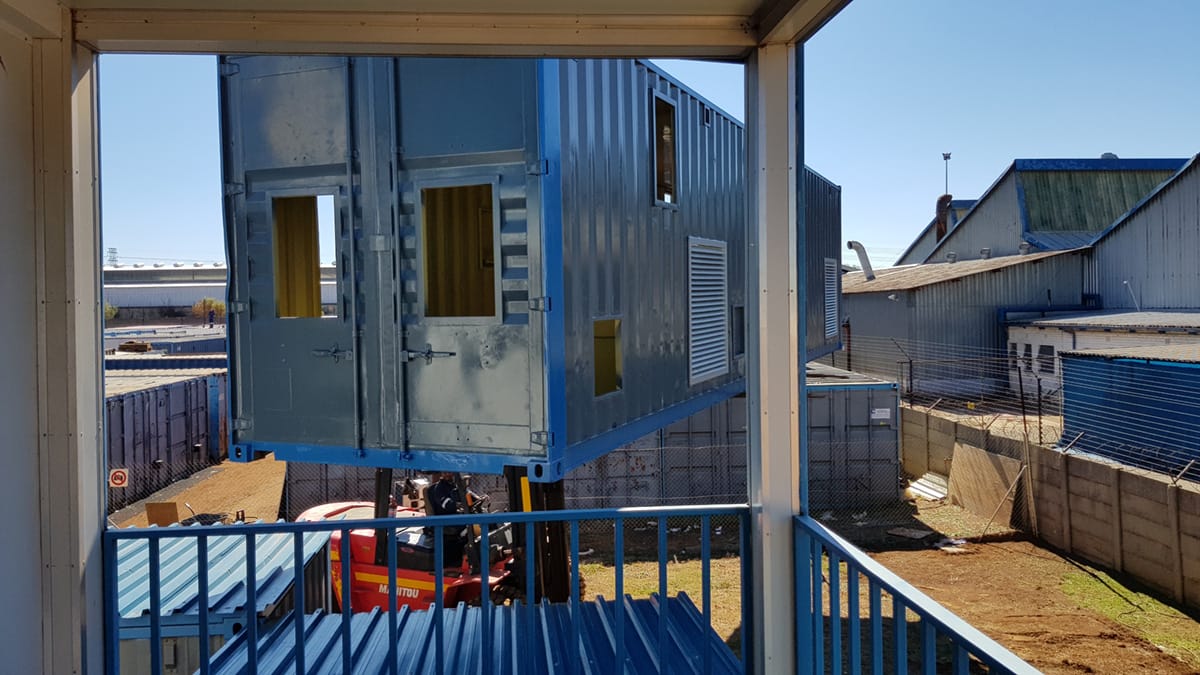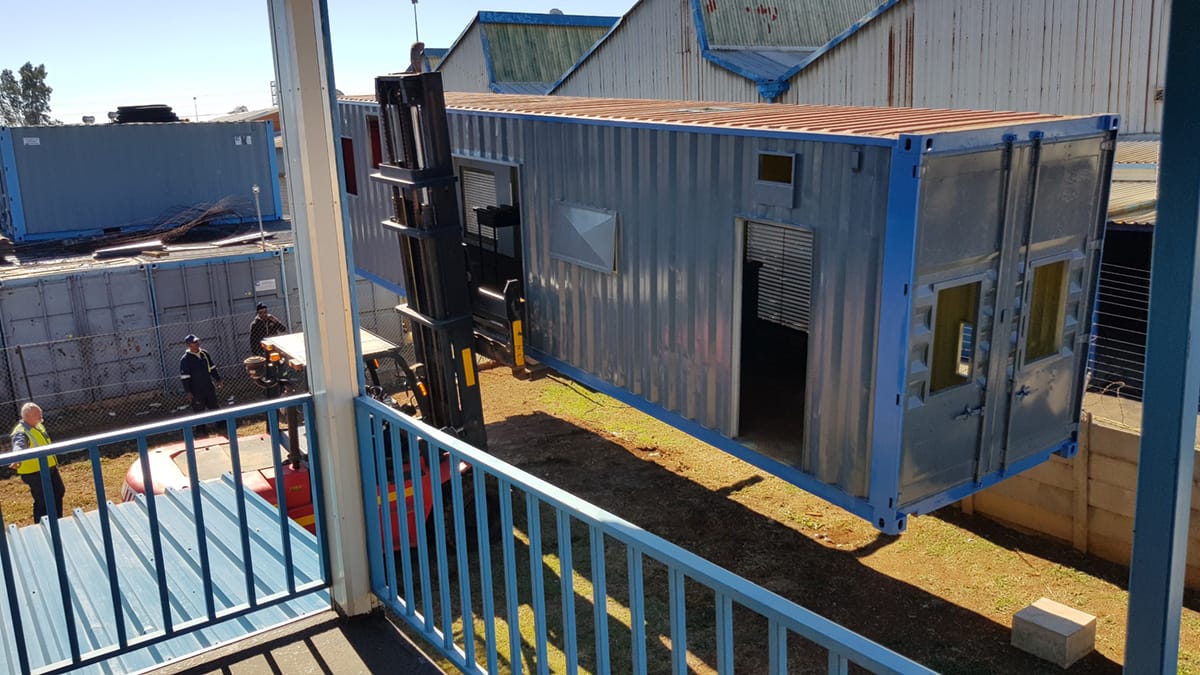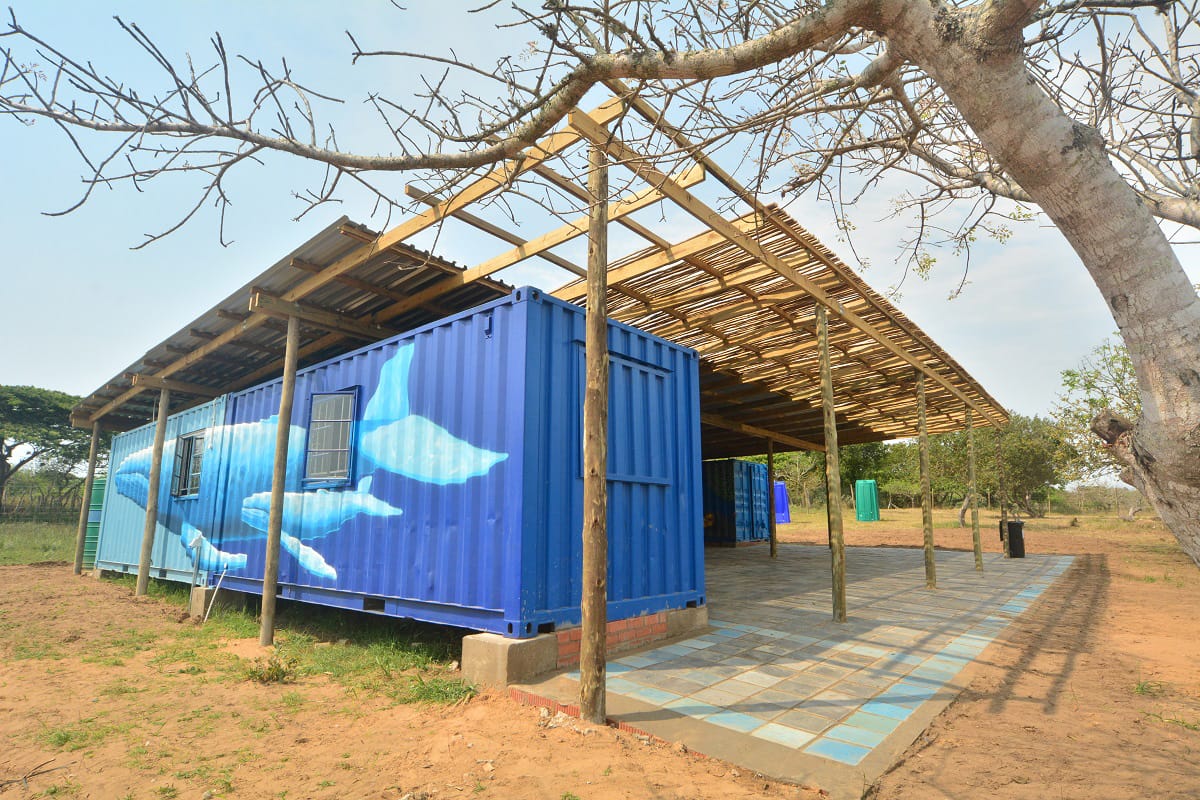Container Conversions Counts on Simplicity to Provide Critical Solutions

Container Conversions PTY Ltd. has always been in the container business. The South Africa-based company started out converting wooden railway carriages and shipping containers, expanding their business to include modular offerings in the mid-1990s.
Originally based out of Durban, KwaZulu-Natal, Container Conversions has since expanded to include branches in Pretoria, Johannesburg, and Cape Town. The company also owns five depots where they prefabricate modules off-site, servicing all of South Africa and a host of neighboring countries. But the company has the ability to export throughout Africa and beyond.
Container Conversions has fabricated and developed thousands of containers for varied projects, including rental refrigeration options, offices, kitchens, temporary workplace housing, and mobile health clinics.
Because of their location, Container Conversions has also developed highly insulated projects for use in Antarctica.
In 2014, the company created Modular Site Solutions as a separate export division to continue modular fabrication. Container Conversions also acquired Big Box Containers in 2023 to amplify their existing container business and expand geographically in South Africa.
Three Reasons to Go Container-First
CEO Guy Murray says there are three main advantages to using containers: durability, versatility, and speed. Container Conversions sources their containers from a few different places, such as international container retailers, shipping companies, and container factories in China.
“The structures are strong, built to withstand extreme conditions, and with care, their lifespan can be extended significantly,” he said.
With five depots across South Africa, Container Conversions can transport modules with a dedicated truck fleet in one to two days. They also ship projects from Durban, which hosts one of the busiest ports in Africa.
“We are pretty much a springboard for anybody that wants to do work in Africa,” says Group Marketing Executive Willie Ward.
For customers looking to expand or create different structures, stacking or joining is a viable option, which speaks directly to the versatility offered by containers. According to Guy, an average project can take about two to three months, “depending on scale and technicality, whilst more standard conversions can be mere weeks.”
They are also easily moved, which is a plus for customers that require temporary work housing or facilities.
Lastly, because of their predetermined dimensions, containers are already self-made structures that aid in the “rapid plug-and-play accommodation solution,” says Guy.
“We find them ideally suited to projects with short lead times where the solution is temporary or intermediate, and where space constraints necessitate stacking into two or three stories.”
Providing Infrastructure for Hard-to-Reach Areas
Part of what makes Container Conversions as a company so successful lies in their location. They can mobilize and provide turnkey solutions in rural areas where resources are scant. One such case was in 2020, at the start of the COVID pandemic.
The company was tasked with developing a 12-to-24 bed COVID isolation ward for a rural area in KwaZulu-Natal and to have it up and running as soon as possible. They developed a 360 square meter ICU facility with an ancillary building that is still in use to today as a primary healthcare facility.



“Conventional building, especially in the remote rural area allocated, could not have met the imposed deadlines and consequently modular construction was identified as the preferred building method,” said Guy. “Modular Site Solutions was awarded the contract and essential supplier status to operate during lockdown in April 2020. The new hospital ward admitted their first COVID patient on March 7, 2020.”
Due to the stringent requirements set by the Department of Health in South Africa, this building had a variety of special furnishings and MEP designs, including “positive pressure ducted air-conditioning,” said Guy. Additionally, the ancillary building—another shipping container unit—protected the manifolds and vacuum suction required to keep the isolation ward sterile. All the initial modifications were done off-site so the buildings could truly be “plug and play.”

Mobility Leads to Accessibility with Containers
Container Conversions has also worked to produce one-of-a-kind sanitation solutions to address health and safety issues across South Africa. According to the Associated Press, the Department of Basic Education says that as of 2023, over 3,300 schools still use pit latrines—outhouses that feature 10-foot holes with a concrete or wooden slab covering used to collect human waste. These pit latrines pose a dangerous hazard to children, as they can fall in and drown.
“There is a dire need to provide sanitation in rural schools and outlying areas where there is limited services and infrastructure,” said Guy. “Many of these areas use pit latrine toilets which are dangerous and unhealthy for the occupants.”
In 2023, they developed a container unit alongside the company Waterloo that reuses water within a closed circuit, requiring no hookups to sewer connections or fresh water. Over the course of a year, the two companies worked together to create a unique system that recycles and cleans water within a toileting system. The unit comes with a 6,500-liter capacity recycled water tank, alongside a bioreactor and disinfection tank.
According to Willie, the Waterloo solution features one container with a raised platform with eight toilets on top of the tank filtration system. For larger sites, an additional container can be provided to store materials.
One of these self-contained toilet units was tested at a secondary school in Newcastle, KwaZulu-Natal and proved to be a success. The two companies trialed eight additional toilets that were in use by up to 1600 students.
Waterloo is now working to market the container toilet solution system to the Department of Education in South Africa in addition to other global nonprofits and companies that have strong corporate social responsibility aims.
It’s this work that makes Container Conversions stand out as a company, while they also seek to furnish container units and modules for other more “traditional industries” and uses, like living spaces.
Making Living Quarters Available for Tough Jobs
Containers have also been used to provide temporary housing for those in remote work areas. Guy says that there are a host of companies that look for temporary housing for their workforce in a number of situations. The company is currently developing a large workforce housing project for a mining company out in Mozambique. The project includes about 100 container units that include “offices, boardrooms, sanitation blocks, and sleeping quarters,” says Guy.
In a nod back to its railway carriage days, the company has also developed four unique containers for a train transport company that requires a three-person staff for maintenance. The four containers feature several amenities that make it easy for the staff to rest, cook, wash, and live as they travel across remote train routes in Africa.

Container Design is About Simplicity
At the end of the day, Guy and his team at Container Conversions stay on top of their business by providing a mix of rental offerings and unique modular designs, as noted by the variety of their projects.
However, in order to keep the train chugging along, Guy says that it’s important to keep everything simple.
“Keep the design simple and functional,” he says. “This will allow for faster output times and reduced costs. Be very clear on what must be achieved by the project. Sometimes a container is not the best solution and that is where other modular products come in. But understanding your space, what you want to do inside the space—and the transport logistics involved—is key.”
About the Author: Karen P. Rivera is a freelance writer and editor with a passion for storytelling. She is a former United Nations-based reporter, with experience covering international breaking news, venture capital, emerging healthcare tech, and the video game industry.
More from Modular Advantage
Resia: Breaking All the Rules
Resia Manufacturing, a division of U.S.-based Resia, is now offering prefabricated bathroom and kitchen components to industry partners. Its hybrid fabrication facility produces more precise bathroom and kitchen components (modules) faster and at lower cost than traditional construction. Here’s how Resia Manufacturing does it.
How LINQ Modular Innovates to Bring Modular To The Market in the UAE and Beyond
LINQ Modular, with an office and three manufacturing facilities in Dubai, is a modular firm based in United Arab Emirates. The company is on a mission: to break open the housing and construction markets in the Gulf Cooperation Council (GCC) area with modular.
ModMax: Redefining Modular Construction with Confidence and Precision
ModMax was born out of frustration—frustration with five persistent pain points in modular construction: Permitting bottlenecks. Production delays. Rigid designs. Disconnect between “the office” and the field. Lack of transparency and communication.
LifeArk: Disaster-Resilient Housing from Recycled Plastic and 100-year-old Technology
Wee compares LifeArk’s housing units to Yeti coolers, as they are built similarly. Each component takes 15 to 20 minutes to manufacture, has an R-value of 40, and includes molded slots and chases for wiring, plumbing, fire sprinklers, and other utilities.
Building the Future of Modular Edge Infrastructure
The edge data center market is expanding rapidly, driven by the surge in AI workloads, IoT adoption, and the need for localized compute power. In these environments, sustainability, scalability, and reliability are non-negotiable. Cooling is among the most complex challenges for operators—and one of the most decisive factors in long-term success.
Accelerating Light-Gauge Steel Construction: A Semi-Automated Digital Workflow for Off-Site Projects
For construction professionals, the message is clear. By adopting semi-automation and digitalization, companies can deliver projects faster, more accurately, and more profitably, while also building stronger collaboration across teams. The approach is not about replacing people with machines, but about empowering people with better tools and processes.
Why Modular Data Centers Are Gaining Momentum
Artificial intelligence, high-performance computing, and edge applications push the limits of traditional “stick-built” data centers. They take years build, often struggle with high density workloads, and aren’t optimized for deployments near end users. Modular data center platforms are purpose-built to address these challenges, offering flexibility and scalability to adapt to evolving technologies, while opening new opportunities for the modular construction industry.
Supply Chain Innovation in Action: 5 Habits Every Modular Leader Should Practice
By applying these principles to supply chain practices — collaborative planning, strategic procurement, scenario modeling, digital tools, and transparent forecasting — construction leaders can build value chains that are not just efficient and agile, but truly innovative.
Exploring the Role of Modular Integrated Construction (MiC) in Advancing Circular City Principles – A Survey of Stakeholder Perspectives
The survey findings highlight the significant potential of Modular integrated Construction (MiC) in advancing the development of circular cities. By reducing costs, accelerating construction timelines, and minimizing waste generation, MiC offers a promising approach to sustainable urban development.
The Use of MS POLYMER™-Based Sealants and Adhesives in Modular Building
These products combine flexibility and elastic recovery with excellent adhesion to different substrates and have already shown their usefulness in traditional construction. Now it’s time for them to be put to use in the modular construction industry.










